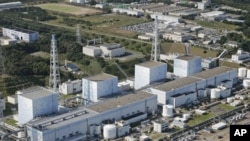Authorities in Japan have evacuated the area around a nuclear power plant after its reactor's cooling system failed following Friday's massive earthquake. Pressure began building overnight at the Fukushima Daiichi plant north of Tokyo, prompting officials to consider venting radioactive vapor on Saturday. The situation has prompted analysts to debate whether nuclear power is safe to use in earthquake-prone regions.
Japan has 55 nuclear power plants that produce nearly one-third of the country’s electrical output. Its also lies in one of the most seismically active zones in the world, known as the Pacific Ring of Fire.
Nuclear waste specialist Kevin Kamps at nuclear watchdog Beyond Nuclear says these two factors put Japan at a big risk. "An earthquake that damages multiple levels of the safety systems can lead to a troubled situation very quickly."
Kamps said the worst case scenario for the Fukushima Daiichi plant would be what happened at the Chernobyl nuclear power plant in Ukraine in 1986, when the radioactivity escaped to the outside environment, causing environmental and health hazards across portions of Europe. He said Japan should consider other energy options.
"There are much safer sources of electricity; renewables, like wind and solar, could not suffer catastrophic disasters like this that endanger entire regions with hazardous radioactive releases."
Analyst Jeremy Gordon with the World Nuclear Association, however, said overall the situation is not one in which Japan would need to abandon this major source of electricity. He said Japan's nuclear plants are built with multiple safety layers and earthquakes in mind.
"The engineering standard goes so far beyond what you would ever expect, and the regulations go far beyond what you would ever expect. The end result is that the power plants are extremely robust."
Gordon said a powerful earthquake that struck the Kashiwazaki-Kariwa nuclear power plant in 2007 is an example of the effectiveness of nuclear power plant safety measures.
"They were hit really hard and there was damage within the plant and it took a long time to repair everything. But the safety system stayed in place and there was no nuclear risk from that earthquake."
Kamps said the Fukushima Daiichi situation, though, should be a wake-up call to the Japanese government and the world about the dangers of nuclear power plants. This can include radiological contamination of the environment and genetic damage, cancer and a wide spectrum of disease within people.
"A nuclear disaster anywhere is a nuclear disaster everywhere. We saw that at Chernobyl with significant nuclear fallout blanketing Europe in all directions for many hundreds of miles. We even saw fallout here in the United States," said Kamps.
But Gordon believes Japan has no other sustainable energy options. "It's been using nuclear power since 1966 and its main reason for doing that is because it doesn’t have any energy resources of its own at home. It doesn't have coal. It doesn't have gas. So it needs a sustainable and controllable domestic source of energy."
Greenpeace nuclear policy analyst Jim Riccio says the consequences of nuclear power need to be considered. "I think it's a good reminder, we've been focusing a lot lately on the downsides of nuclear in terms of its finances, there are other downsides beside the financial downside, potential for a meltdown and I think it should give people pause before they pursue new reactors here in the United States and around the world."
The International Atomic Energy Agency estimates that 20 percent of the world's nuclear reactors are in areas of significant seismic activity.










